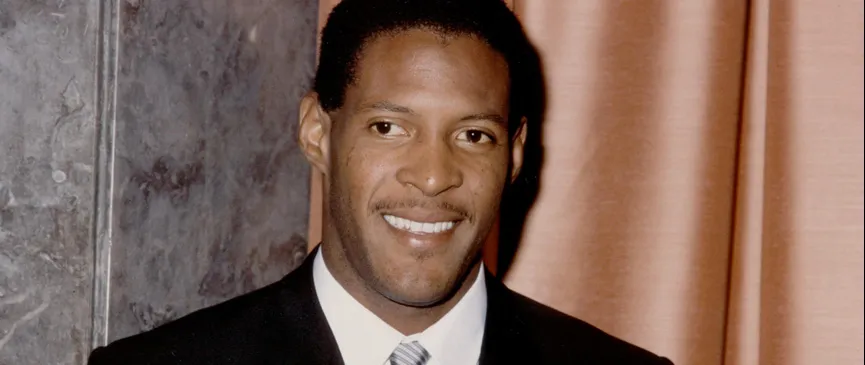Main content
Javier Sotomayor Prince of Asturias Award for Sports 1993

Javier Sotomayor Sanabria (Limonar, Matanzas, Cuba, 1967 - ) is a Cuban former athlete considered the foremost high jumper in the history of the event. He holds world outdoor and indoor records and, during his career, he won an Olympic gold medal, two World Championships, four World Indoor Championships and three Pan American Championships, among other achievements. He set his first record at sixteen years of age, when he cleared two metres. He then began his specific preparation for the high jump, moving to Havana with a scholarship from the Escuela Superior de Perfeccionamiento Deportivo that allowed him to advance considerably in his training.
In 1984, at the age of sixteen, he set the still-existing 2.33m junior world record in Havana. Junior world champion in Athens 1986, he holds the three best records in that category, the others being those he set in Havana and his 2.30 m jump in London. The Cuban boycott prevented him from attending the Seoul Olympics. A year later, he won the Budapest World Championships, where he cleared 2.43 m, and Puerto Rico, where he jumped 2.44 m. The latter record stood until he cleared 2.45 metres in Salamanca that same year. He was the second Cuban athlete to set a world record, after Alberto Juantorena (in 400 metres, 1976). In 1990, a foot injury impeded him from competing. He came back to win the gold medal in the Central American and Caribbean Games held in Mexico City. Subsequently, in 1991, he made his second appearance in a world championship, in Tokyo, coming second with a jump of 2.36 m. In March of that year, he shared third place with the Soviet athlete Alexei Yemelin (2.31 m) in the World Indoor Championship held in Seville and in August achieved his second consecutive victory in the Pan American Games with a jump of 2.35 m. Sotomayor competed in the Olympic Games for the first time in 1992, in Barcelona, winning a gold medal (2.34 m). In 1993, he won the World Indoor Championship in Toronto, Canada, with a jump of 2.41 m, thereby regaining the title he had lost two years earlier. Some months later, before the world championship in Stuttgart, Germany, Sotomayor participated in the annual meeting in Salamanca, jumping 2.23 m, 2.32 m and 2.38 m in a single attempt, finally achieving a jump of 2.45 m that beat his own world record by one centimetre.
Sotomayor returned to the World Indoor Championships in 1995, where he cleared 2.37 m, winning the gold medal for the third time. He also competed for the third time in the Pan American Games, held in Mar del Plata, Argentina, and once again won the gold medal with a jump of 2.40 m, setting a record for this competition that still stands. Meanwhile, at the World Championships held in Gothenburg, Sweden, he came second with a jump of 2.37m. At the Atlanta Olympics, he barely cleared 2.25 m due to an injury to his left leg. At the 1997 World Championships, he jumped 2.37 m, once more winning the gold medal. In 1998, his most relevant results were first place at the Grand Prix Final in Moscow, with a jump of 2.31 m, and second place at the Athletics World Cup held in Johannesburg, with a jump of 2.28 m.
He was accused of drug-taking following the Pan-American Games in 1999 and was suspended. The IAAF decided to shorten his suspension to one year. The members of the board decided to give him an “opportunity to rehabilitate” based on his “exceptional career”. The IAAF further highlighted the more than 300 anti-doping controls that Sotomayor had passed, all with negative results. The decision was also taken to allow him the possibility of attending the 2000 Olympic Games in Sydney so as to bring his remarkable career to a close. For their part, sports authorities in Cuba such as the president of the Sports Institute were pleased, though not satisfied, as the doubts about Sotomayor’s innocence still weighed heavily. The president of the Cuban Olympic Committee also insisted on “laboratory manipulation”, although he accepted not knowing by whom, nor in what way the parties involved had conspired. He won the silver medal in Sydney with a jump of 2.32 m. At the beginning of 2001, he competed in the World Indoor Championships in Lisbon, coming fifth (2.25 m) and in the Edmonton World Championship (Canada), clearing 2.33 m. In October that same year, he announced that he was retiring from athletics.
He was once again accused of taking drugs shortly after that. The IAAF confirmed the results of the test in January 2002. The decision meant a lifetime ban, but it was no longer effective due to the fact he had retired. Having brought his career in athletics to a close, he obtained a degree in Physical and Sports Culture, which has allowed him to train athletes in his country. He has also held office as president of the Athletes Care Subcommittee and as member of the Cuban Athletics Federation Committee.
Sportsman of the Year in 1988 (awarded by the Spanish Sports Press Association), Cuban Sportsman of the Year and Most Outstanding Athlete of Latin America (awarded by the Prensa Latina Cuban news agency), in 2007 he was inducted to the Central American and Caribbean Athletic Confederation’s Hall of Fame and, in 2011, was distinguished with the “Youth Inspiring Sport” Prize by the International Olympic Committee. He was also invited to the temporary exhibition on the occasion of the IAAF centenary that took place in Barcelona, where the shirt he wore when he set the world record of 2.45 m was on display.
End of main content
